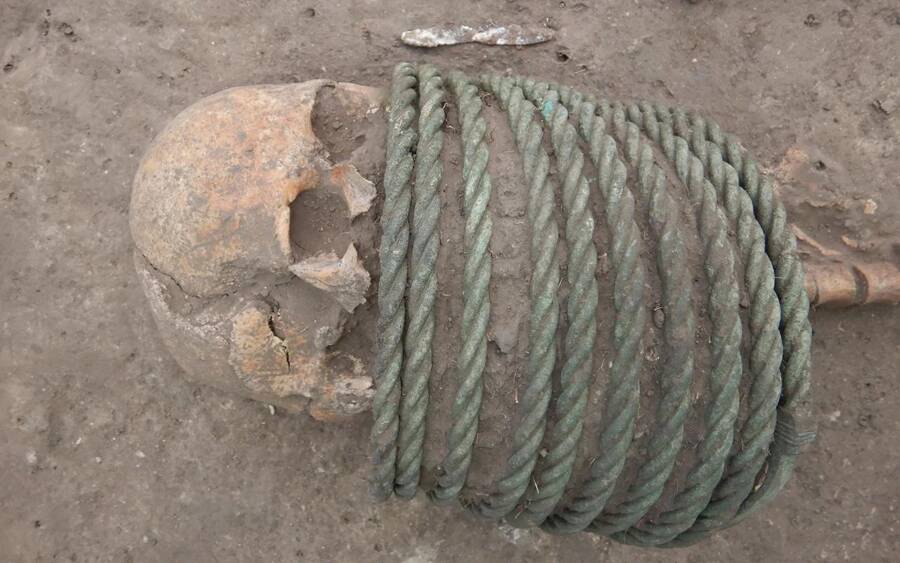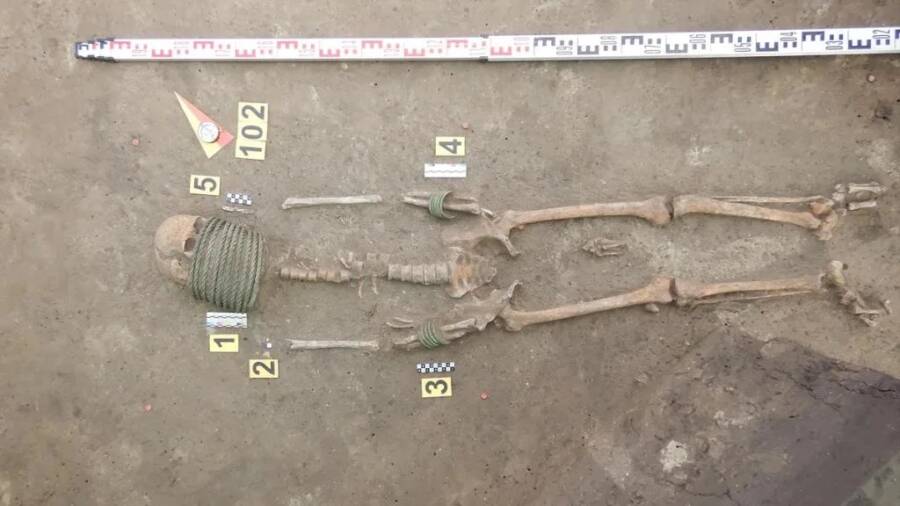The burials at the cemetery near the western Ukrainian village of Ostriv displayed a puzzling mix of Kyivan and Baltic customs.

Vyacheslav BaranovA woman’s skeleton with bronze rings around her neck.
Archaeologists in Ukraine have unearthed a 1,000-year-old cemetery and a number of skeletons buried with rings around their necks and buckets at their feet.
The cemetery was discovered just south of Kyiv and dates back to the 11th century, a pivotal time in Ukraine when many people had begun converting to Christianity. In total, there were 107 graves found at the site, with most of the remains in wooden coffins.
Skeletons of both men and women were found in the cemetery, some of whom were buried with an assortment of objects, including weapons and jewelry. Some of the men were interred with axes, spearheads, and swords. Meanwhile, several of the women were buried with elaborate rings around their necks. Study co-author Vyacheslav Baranov told Live Science that these bronze rings “were apparently a kind of social marker.”
It is not entirely clear why some people buried at the site had wooden buckets placed at their feet, but experts believe it may have been part of a funerary ritual.

Vyacheslav BaranovAn overview of a woman’s skeleton found in the cemetery.
“Other elements, such as buckets from two Ostriv male graves, are also found at 11th-century Prussian cremation and Pomeranian and Masovian inhumation cemeteries of military elites,” Baranov and project co-lead Vsevolod Ivakin wrote in their study, which was published in the journal Medieval Archaeology.
Curiously, the arrangement of the graves was atypical for burials in the region. Rather than facing north, as was usual for the area, these graves faced to the south and west.
Baranov and Ivakin’s findings were presented in early January at the Archaeological Institute of America’s annual meeting in Chicago.
Excavations at the cemetery began in 2017 and continued through 2022.

Vyacheslav BaranovA skeleton with a broken skull.
In addition to the 107 graves, the archaeologists also uncovered a stone altar. There were various offerings left nearby, including bracelets, beads, and food such as chicken bones and eggshells. This altar could have been used for either Pagan or Christian rituals — or possibly both, as the people of Ukraine were making the transition from Paganism to Christianity around the time the cemetery was in use.
Researchers also noted that the burials at this site were reminiscent of graves found in Baltic regions. Experts theorized that some of the people interred in the cemetery may have traveled to Ukraine to serve under powerful military leaders such as Volodymyr the Great.

Vyacheslav BaranovA bead unearthed in the cemetery.
However, the burials were not entirely consistent with Western Baltic tradition. Whereas many Baltic people practiced cremation, no evidence of this was found at the cemetery site in Ostriv. Perhaps, researchers suggested, this had to do with constraints imposed upon funerary practices by Christian leaders like Volodymyr the Great and Yaroslav the Wise.
Volodymyr the Great’s rule did extend into some Baltic territories, and his own conversion to Christianity around 987 C.E. likely held great influence over his domain.
This excavation was halted due to the ongoing Russian invasion of Ukraine, which has forced various archaeological studies to be put on pause. Thankfully, the project still has a wealth of information to offer about the distant past.
After reading about this 1,000-year-old cemetery unearthed in Ukraine, learn about the discovery of a Slavic warrior woman buried alongside her ax in a Viking cemetery. Then, read about the 1,900-year-old Roman relic that was used as a stepping stone in an English garden.





